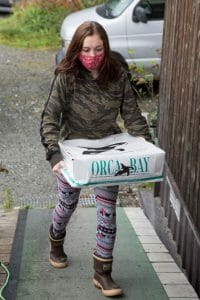Sealaska issued a statement expressing its position on the U.S. Supreme Court’s ruling on Friday, June 25 that settled litigation over whether Alaska Native Corporations qualify for federal CARES Act funding. Click here to read Sealaska’s statement. Answers to additional questions shareholders and tribal citizens may have on the decision and Sealaska’s role are below.

What does the Supreme Court ruling mean for Alaska Native Corporations?
With its ruling in favor of Alaska Native Corporations (ANCs) in Yellen v. Confederated Tribes of Chehalis Reservation, the Supreme Court affirmed a legal definition of “Indian Tribe” that includes ANCs, which has been recognized in federal law for more than 40 years.
For Sealaska, this legal battle was never about CARES Act money, although of course we had an interest in advocating for federal funding that our people and communities need and deserve, to fight and recover from the COVID-19 pandemic. Our interest was in defending the legal status of Alaska Natives who are served both by Tribes and Alaska Native Corporations. There are some significant differences between how Native people are served in the Lower 48 and in Alaska. Tribes in the Lower 48 hold land in trust and are considered sovereign nations. In Alaska, our tribes are sovereign, but do not own much if any land. Land claims were settled with Alaska’s Indigenous people through the Alaska Native Claims Settlement Act, which is also the legislation that established ANCs. Our Native rights are held by more than Indian Tribes; namely ANCs and non-profit Native organizations. We fought to uphold the legal definition of “Indian Tribe” in certain federal programs to include ANCs, because many such programs and benefits are associated with our role as Native landowners. However, this does not mean that we are or that we plan to assert sovereign tribal authority.
From a practical standpoint, the Supreme Court’s decision means that approximately $450 million of the $8 billion in federal funding designated for tribal governments to respond to the COVID-19 pandemic will flow to ANCs. The formula by which the funds will be distributed has not been determined yet, and at this point Sealaska does not know how much it will receive.
What does it mean for Sealaska?
The formula by which the funding will be distributed to ANCs has not yet been determined, and it is possible that Sealaska’s share will be very small. We intend to distribute our share in coordination with our tribal partners, including Central Council of Tlingit & Haida Indian Tribes of Alaska (T&H), Ketchikan Indian Community and Sitka Tribe of Alaska. These organizations have successfully stood up programs and distributions under the CARES Act that Sealaska wants to follow.
CARES Act programs are based on COVID-related impacts, which means funding can only go to applicants who can demonstrate personal- or business-related impacts from the pandemic. We are honored to play a role in supporting our shareholders, following the excellent work our tribes have done in responding to the needs of their citizens.
How and when will the money be distributed?
The CARES Act was a $2 trillion piece of legislation passed by Congress in March of 2020 to address the immediate impacts of the COVID-19 pandemic. The Coronavirus Relief Fund (CRF) is a subset of the original act that contained $8 billion for payments to tribal governments. Of the $8 billion, $500 million was set aside for Alaska Native Corporations, which was subsequently reduced to $450 million.
Now that the Supreme Court has ruled, funding will be released to Alaska Native Corporations based on Treasury Department funding allocation formula. We do not know exactly when this will happen or how much our allocation will be.
What will the money be used for?
The requirements of the CARES Act stipulate that funds must be distributed based on need as a result of COVID. Our tribal partners have each created their own processes to determine need among tribal citizens and distribute funds on the basis of need. Sealaska will distribute its portion of the $450 million in coordination with the tribes in our region.
Can this decision be appealed or is it final?
It is essentially final.
What are the requirements for receiving relief assistance through the CARES Act?
Each tribe has its own program. For information on programs, applications and eligibility, please contact your tribe’s CARES Act coordinator. If Sealaska stands up any new programs, we will share that information and any associated requirements with all shareholders.
How else is Sealaska addressing the impacts of the pandemic on shareholders?
When the pandemic struck, Sealaska immediately committed to providing $1 million in emergency relief funding to shareholders, and ultimately distributed $1.43 million through a variety of programs and partnerships. Sealaska also made its spring distribution to shareholders two weeks earlier than normal to provide immediate financial assistance. We have worked closely with our tribal partners and the Southeast Alaska Regional Health Consortium (SEARHC) to support their efforts and understand the needs and impacts in our region and among our people wherever they live.
Why did Sealaska engage in this legal fight?
Sealaska’s interest in this was not solely about the CARES Act money. Many federal programs hinge on the definition of “Indian Tribe” in the law or program. We engaged in this fight because a change in the interpretation of the Indian Self Determination and Education Assistance Act’s (ISDEAA) definition of “Indian Tribe” would have had devastating impacts on Alaska Native Corporations and our shareholders across many programs and aspects of our businesses. The use of the ISDEAA definition that includes ANCs allows federal programs to benefit all Alaska Natives and the unique structure of organizations that we have supporting our Alaska Native people. It reflects the fact that Alaska has a different structure than Lower 48 Tribes.